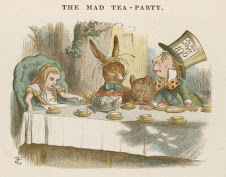When seeking to dissuade others from engaging in third party and independent political activism, liberal and conservative advocates of the two-party state and duopoly system of government often argue that it is better to wage primary challenges against sitting incumbents than it is to stand in principled opposition to the ruling political class by supporting third party and independent candidates for office. This is likely one of the primary mechanisms of what is commonly called 'political polarization.' At
the Whig, Septimus argues that this process results in the alienation of moderate voters:
One of the arguments against the need of a new political party is the assertion that party primaries make a new moderate party unnecessary. As the argument goes, since political parties have primaries, the voters get a say in who a party nominates, thereby removing the need for a new, moderate political party.
Such an argument fails in reality. Political party primaries tend to favor the extremes of each party, as the voters in the primaries are self-selected and do not represent the needs or desires of those in the middle. Party primaries are dominated by activists with an agenda, who prefer purity to the advancement of the common good . . . As a result, party primaries tend to push the candidates to the extremes.
Ironically, liberal and conservative efforts to ensure the reproduction of the two-party state and duopoly system of government in this way arguably create optimal conditions for third party and independent candidates to break open the Democratic-Republican lock on elected office. At
Pollster, Michael McDonald finds that the more ideologically cohesive the major parties are, the more likely one is to see gains by third party and independent candidates. Via
Ballot Access News:
In the figure below, I plot from 1870-2006 the effective number of parties elected to the US House (black line) along with a measure of the ideological cohesiveness of the two major party's caucuses (blue and red lines) . . .
Minor parties have greater electoral success when the major parties are more ideologically cohesive . . . Since 1982, the congressional parties have again become more ideologically cohesive . . . As American parties become more ideologically rigid, more space is provided to minor party candidates to flourish. If so, then we may be on the verge of at least some electoral success for minor political parties.
Follow the link for the accompanying graph and detailed analysis.







2 comments:
Interesting, but isn't it likely that some of the "electoral success" of minor parties can be traced to the process of ideological cohesion rather than the accomplished fact of it? I'm thinking of episodes like the NY 23rd district special election, when a strong third-party candidate emerged, but only as an attempt to enforce ideological discipline on a major party that had nominated a "deviant" candidate. Overall, though, the article makes perfect sense, especially when you consider regional differences in ideological intensity. Any national effort to impose a one-size-fits-all ideology on the Republican Party, for instance, could provoke a third-party reaction from traditional partisans who nevertheless reject attitudes they identify with the Bible Belt or other "alien" parts of the country.
I really want to look into this "effective number of parties" thing more, but checking the house clerk's biographical data for that highest-spike year, 1876, a first past shows, other than straight-up Rs and Ds:
1 "independent democrat"
3 "independent republicans"
(1 of which was previously elected as a straight-up republican)
(1 of which was elected as an "anti-monopolist")
5 "independents"
(2 of which were previously or later elected as straight-up republicans)
If that counts as the "greatest success of third-parties ever" then... ::sigh::
Post a Comment